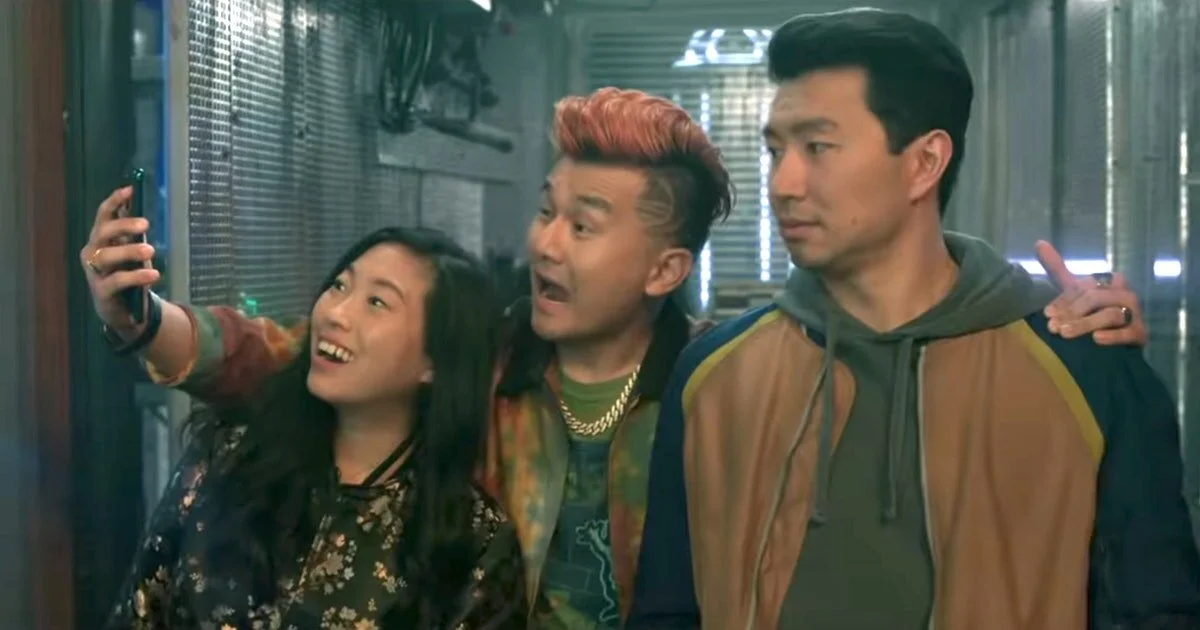Shang-Chi and the Legend of the Ten Rings Delivers Impeccable Kung-Fu and Visuals
Simu Liu and Michelle Yeoh as Shang-Chi and Jiang Nan in Shang-Chi and the Legend of the Ten Rings. (Courtesy of The Walt Disney Company)
Marvel’s latest movie Shang-Chi and the Legend of the Ten Rings, directed by Destin Daniel Creton, starring Simu Liu, introduces the first Asian superhero to grace the Marvel Cinematic Universe. Currently, the kung-fu action film is the 4th highest grossing movie of 2021 with a global revenue of 257.6 million. It was funny, fast-paced, and breathtakingly beautiful.
Set in San Francisco, our hero’s story begins in an unglamourous reality: Shang-Chi (Simu Liu) works as a valet alongside his best friend, Katy (Awkwafina). His life plummets into chaos when he’s attacked by assassins working for his dad. Xu Wenwu (Tony Leung Chiu-wai), Shang-Chi’s father and leader of the Ten Rings, plans to destroy the mystical village of Ta Lo. Caught in a battle between good and his own blood, Shang-Chi must defend Ta Lo and the dark secret it holds from his father’s warped intentions.
Initially, I was unsure about how I would feel about our main protagonist. In the trailers, Shang-Chi seems like your traditional, disciplined, earnest hero who wants to do good—an overused and uninteresting trope. To my pleasant surprise, he was a highly likeable and humorous character, mainly due actor Simu Liu’s charisma.
Shang-Chi and the Legend of the Ten Rings is one of the most aesthetically beautiful Marvel movies out there. It portrays a wide variety of atmospheres, ranging from urban San Francisco, to the forbidding and militaristic Ten Rings’ compound. By far the most striking setting is the magical world of Ta Lo, which instills a unique, fantastical element that sets Shang-Chi apart from its predecessors. The production team took inspiration from many traditional Chinese symbols, such as the Tang and Song dynasties, drawing from several different time periods and regions. “It was just fun to take some really great strong fundamental concepts that were rooted in Chinese culture and then run with them.” production designer Sue Chan told Variety. Magical water, majestic dragons, and bewitched bamboo forests provide enchanting eye-candy to viewers.
Shang-Chi and Razorfirst fight on a bus down the San Francisco streets. (Courtesy of The Walt Disney Company)
In the comics, Shang-Chi is known as the “Master of Kung Fu,” so it comes as no surprise that his movie has some of the best fight scenes in the Marvel Cinematic Universe. One of my favorite fight sequences was the showdown between Shang-Chi and Razor-Fist on a moving bus. The scene demonstrates not only impressive physical feats on the part of Simu Liu (who didn’t use a stunt double), but incorporates a sense of humor that varies the dynamic. Amid the intense skirmish, one passenger starts live streaming the event while another is understandably dismayed when Shang-Chi blocks a blow using her laptop. Fight coordinator Andy Cheng told Insider "It was about fine-tuning. Not too comedy, not too martial arts, not too serious. We were juggling the story and character and the tone and mood."
Shang-Chi doesn’t use just one martial arts style. His movements are representative of his upbringing, as they are a combination of the deeply distinctive styles of his parents. Shang-Chi’s mother practices Tai Chi methods; her movements are flowy and graceful. In contrast, his father Wenwu had an adolescent Shang-Chi training constantly to learn a more forceful, combative style that took inspiration from Wing Chun.
Our main lead may be a man, but Shang-Chi and the Legend of the Ten Rings introduces us to several new, equally awesome heroines. Throughout the movie, Shang-Chi is surrounded by the women in his life, from his best pal Katy who saved him from the school bullies, his sister Xialing, who started her own underground fighting empire, and his aunt (Michelle Yeoh), a fierce Ta Lo warrior. Director Cretton told io9 “It was a natural part of the process to have Shang-Chi surrounded by so many strong women… who are not only just supporting characters but are all on their own journeys themselves.” Shang-Chi’s mother, though deceased, is also present through flashbacks and the mantle she left behind for her children to uphold.
Meng’er Zhang as Xialing in Shang-Chi and the Legend of the Ten Rings. (Courtesy of The Walt Disney Company)
While I appreciate the care taken to allow more space for women on screen (Cretton and Marvel were quick to agree the cast’s proposals about certain changes made to their characters), I wish we could have seen more of Xialing (Meng’ er Zhang), who I believe needed a bit more time to become fully developed.
Despite easily beating her brother in the fighting ring, it is Shang-Chi, not Xialing, who goes to stop their father from destroying Ta Lo. And yes, the movie is named after him, so Shang-Chi himself inevitably deserves to be a center player in the final battle. But still, wouldn’t it have been more interesting if Xialing was included? That way the entire family, not just the men, would be forced to confront each other and engage in the epic final fight that blurred the lines between bitter enmity and a longing for reconciliation. Generally, I felt that Marvel’s Black Widow, released earlier this year, did a better job at portraying a troubled family’s reckoning with the past.
Nevertheless, I’m excited to see what Xialing will be up to next, especially since the ending credits scene leaves it ambiguous as to whether she’ll be on the side of the good, the bad, or the morally grey. Whatever it is, I’m sure she’ll have her hands full as the new leader of the Ten Rings, which now trains women along with men.
Shang-Chi and the Legend of the Ten Rings owes its comic relief to performers such as Awkwafina as Katy Chen (left) and Ronny Chieng as Jon Jon (middle). (Courtesy of The Walt Disney Company)
Speaking of women, Shang-Chi’s movie wouldn’t be the same, without the vivacity and humor of his childhood friend Katy. Their relationship is a refreshing shift from most male-female relationships we’ve seen throughout the MCU, in which female characters are often relegated to being defined by their romantic relations with male heroes. From the get-go, their friendship is clearly established as platonic and nothing in their interactions seems to conflict with that.
It’s only a moment towards the end of the movie when Katy and Shang-Chi rest their heads against each other that leaves fans with questions. According to Variety’s Adam B. Vary, Director Cretton told him “We kept going back and forth… A friendship like this —… [where] it's never been romantic but it's also deeply caring and a very real friendship — was something that we don't see very much of in movies. It felt very real to me, and I just didn't feel like we needed to push it beyond that.”
I, for one, am a strong supporter of sticking with what we know works. Their chemistry as friends is amazing, and it would be a shame to have them written into a forced, out-of-nowhere romance.
Much more than a stride in more equal representation, the film delivers a fast-paced action adventure with captivating style. The intriguing visual effects and well-done comedic humor combine to create a compelling watch. And while I was left wanting in some aspects, the impressive highs outweigh the minor disappointments. Overall, Shang-Chi and the Legend of the Ten Rings is a must-watch for all Marvel fans, lovers of familial drama, and kung-fu movie connoisseurs.




